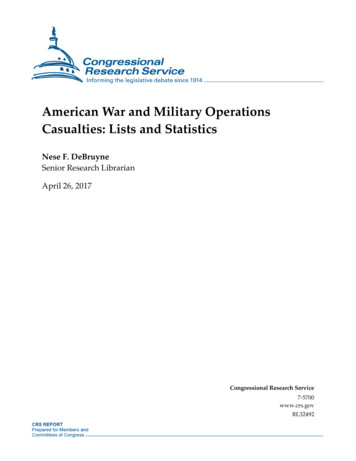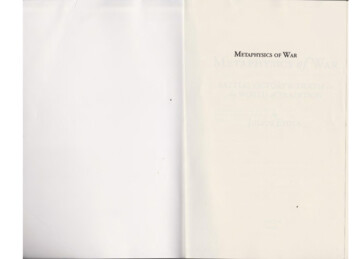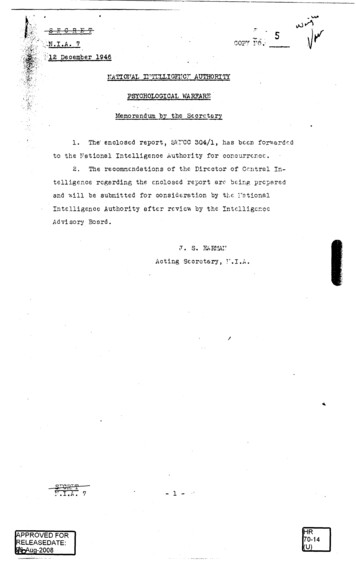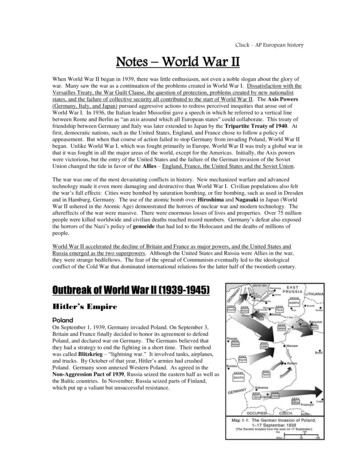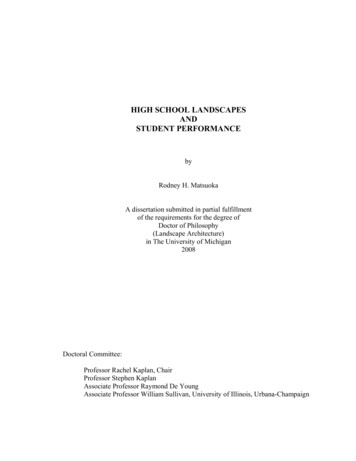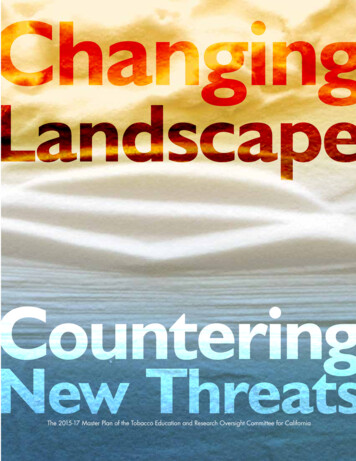
Transcription
WAR OF NERVES:PSYCHOLOGICALLANDSCAPES OFTHE COLD WARSeptember 16, 2018 toJanuary 13, 2019A
WENDEMUSEUMO F T H E C O L D WA RINTRODUCTIONFor forty years, two superpowers faced each other with fear, distrust, and nuclear brinkmanship. The “warof nerves” between East and West involved the promise of mutually assured destruction and an uneasydétente. The Cold War also took place on an individual level, as governments sought to influence theirown as well as enemy populations, and experimented with controlling people’s minds, involving bothscience and pseudo-science. War of Nerves looks at the psychological landscapes in East and West.The exhibition is structured around five sections. A Climate of Fear examines different responses to thefrightening new prospect of nuclear war, and the comfort of an organized response. Know Your Enemyexplores the role of film in creating stereotypes of the enemy, including the enemy within. At the centerof the exhibition, Mind Control looks at the invention of the idea of “brainwashing” and the attemptedsubversion of individual willpower in the battle for Cold War hegemony. The effect of global politics onchildren’s psyches is addressed in A Cold War Childhood. The final section, Dissent and Activism, showcasesresponses from protestors, including members of the medical professions, who refused to acceptnuclear war as a possible outcome of the battle of ideologies.The Cold War was not only a period of armed standoff but also a project to shape minds both collectivelyand personally. While the Cold War now indicates a historical period, Cold War narratives – and nuclearthreats – continue to inform and shape our world. This exhibition wants to provoke discussion asmuch as historical reflection.Curated by Danny Birchall and Joes SegalCuratorial consultants: David Welch and Kate DollenmayerExhibition design and development: Amanda RothWar of Nerves is a collaboration with Wellcome Collection, London.Special thanks to the following individuals and institutions for loaning works for the exhibition: Wellcome Collection, London;Taras Young, Anthony Dunne and Fiona Raby, Magnolia Editions, Julie Saul Gallery, Suzanne Treister, Annely Juda Fine Art, P.P.O.W.Gallery, New York, Chris Wyrick,Yevgeniy Fiks, Concord Media, Hidden Persuaders, Las Vegas News Bureau, Johnston Press1
A CLIMATE OF FEARThe Second World War ended in 1945 with the devastation of the Japanese cities of Hiroshima and Nagasaki, as the U.S.demonstrated its powerful nuclear bombs. The Soviet Union did not lag far behind, successfully testing its first nuclearweapon in 1949. As the arms race between the world’s two superpowers accelerated, the threat of a deadly global warbecame increasingly real, held back only by the threat of “mutually assured destruction” and, especially in the Westernworld, the rise of war-weary public opinion.For some people, the fear of nuclear destruction was an unbearable source of mental stress. For others, more personalfears were symbolized by the threat of the atomic bomb. But preparation for the worst could also become part of sociallife. Civil defense activities, including medical preparations for the aftermath of an attack, paradoxically and somewhatperversely strengthened the bonds of civilian society.Atomic CloudsThe image of the atomic mushroom cloud, first witnessed in Japan, became familiar through U.S. nuclear tests in the 1950s.A mixture of fear and elation about this powerful new phenomenon is expressed in the photo of Miss Atomic Bomb, thewinner of a beauty pageant held in Las Vegas, near the site of the atomic tests.George R. Caron, Atomic cloud over Hiroshima, August 6, 1945,1945, United StatesDon English, Miss Atomic Bomb, 1957, United States Courtesy Las Vegas News BureauMilitary personnel observing one of the tests in the Buster-Jangle Series, November 1, 1951, 1951, United States2
Charles Levy, Atomic Cloud Rises Over Nagasaki, Japan, August 9, 1945,1945, United StatesThe “Baker” explosion, part of Operation Crossroads, a nuclear-weapon test by the U.S. military at Bikini Atoll,Micronesia, July 25, 1946, 1956, United StatesOperation Upshot-Knothole Grable at the Nevada Test Site, May 25, 1953, 1953, United StatesBruce Conner, Bombhead, 2002, United StatesCourtesy of Magnolia Editions, Oakland, CA, and Conner Family Trust, San Francisco3
Front page of The Lancashire Evening Post, Thursday, August15, 1957, United KingdomDunne & Raby/Michael Anastassiades, Huggable AtomicMushroom: Priscilla, 37 Kilotons, Nevada, 1957, from theseries Designs for Fragile Personalities in Anxious Times,2004–5, United KingdomCourtesy of Johnston PressCourtesy of Anthony Dunne and Fiona RabyProtect and SurviveCivil defense encouraged civilian populations to anticipate the terror of a nuclear attack. Being prepared, andtaking medical precautions for the aftermath, allowed for a sense of control over the uncontrollable.Anti-Radiation Shelters, 1978, Soviet UnionWende MuseumMakeshift Shelters and Prefabricated Shelters with Simplified Equipment, 1978,Soviet UnionWende MuseumTwo posters from “General knowledge to protect againstnuclear attack: emergency measures at the time of anuclear explosion” series, 1971, ChinaWellcome Collection, London4
Life Magazine, January 12, 1962, United StatesWende MuseumPopular Science, September 1959, United StatesWende MuseumFederal Civil Defense Administration, EmergencyShelter Medical Kit C, early 1960s, United StatesWende MuseumSelected items from three medical emergency boxesstored in the nuclear shelter underneath the Capitolbuilding, Washington, DC. The boxes, marked withthe Civil Defense logo, contained among other thingsaspirin, penicillin,Vaseline, laxatives, eye and nose drops,thermometers, surgical pads, and instructional booklets.They were rediscovered in 2011 in the attic of theRussell Office Senate Building.Obsessed with a possible nuclear Armageddon,Albanian state leader Enver Hoxhacommissioned more than 170,000 concretebunkers to be built throughout the countrybetween the 1960s and the 1980s.Elian Stefa and Gyler Mydyti, A Qendra Zjarri bunker in the Albanian Alps at Valbona , from ConcreteMushrooms, 20125
Blast door entrance to the bunker (open and closed), n.d., United States, Courtesy The GreenbrierThe nuclear shelter underneath The Greenbrier, a luxury resort in White Sulpher Springs, West Virginia was built for membersof the United States Congress. This bunker was constructed from 1958 to 1962, and the location was kept a secret until 1992.Civil Defense as a Way of LifeThe short-lived Protect and Survive Monthly encouraged individualsto think about, and prepare for, surviving a nuclear attack.State Office for Atomic Security and Radiation Protection of the GermanDemocratic Republic Field Office, n.d., East GermanyWende MuseumThe Defense of the Homeland - A Sacred Duty, circa 1980,Soviet UnionWende MuseumProtect and Survive Monthly, issue 4, April981, United KingdomProtect and Survive Monthly, Issue 8,August 1981, United KingdomProtect and Survive Monthly, issue 9,September 1981, United KingdomCourtesy Taras Young, coldwar.org.ukCourtesy Taras Young, coldwar.org.ukCourtesy Taras Young, coldwar.org.uk6
Chris Wyrick, Dog of War, 2015, United StatesPeace Council of the GDR, Nuclear Power for Life, 1954, East GermanyCourtesy of the artistWende MuseumBritish Telecom, Loudspeaker Unit WB1400, part of Cold War Early Warning System, 1980s, United KingdomCourtesy Taras Young coldwar.org.ukFederal Civil Defense Administration, Duck and Cover, n.d., United StatesFederal Civil Defense Administration, Facts AboutFallout, n.d., United StatesWende MuseumWende Museum7
Federal Civil Defense Administration,Auxiliary Police helmet, n.d., United StatesWende MuseumDP-22 V Dosimeter and Charger set, 1950s, Soviet UnionWende MuseumRadioactivity Caution Warning Light, n.d., East GermanyWende Museum8
KNOW YOUR ENEMYWith these photographs, Hauswald allows apeek into the countercultural side of public lifein theIn theimages1980s,ofalternativeDuring the Cold War, propaganda was employed by both sidesto GDR.constructthe enemylifestylesthat reinforced existingsuchpunk,andalthoughby to the lackstereotypes. The cinema was particularly suited to the battlefor asheartsminds.stronglyWesterndiscouragedmovies pointedtheSocialistUnityParty,becameanevermoreof political and economic freedoms and human rights in the East; Soviet Bloc films pointed to greed, corruption, andvisibleof everydaylife.both sides of the Iron Curtain.racism in the West. No less important was the crusade againstthepartinternalenemy onHowever, films also became a medium for protest against stereotypes, both in the East and the West.The Challenge of Ideas (1961), United StatesThey Shall Not Pass (1952), CzechoslovakiaDestinies of Women (1952), East GermanyWhat Can We Do About It? (The Threat of Communism) (1960), United StatesShooting Range (1979), Soviet UnionPsychological Operations in Support of Internal Defense and DevelopmentAssistance Programs (1968), United States9
MIND CONTROLThe Korean War (1950–53) gave birth to the new idea of “brainwashing”: the systematic control of others’ minds thatcould change worldviews and political allegiances. Both sides pursued the elusive science of mind control in largelysecretive programs, while also accusing each other of employing underhanded methods in the laboratory and at large.Brainwashing, and associated conspiracy theories, became ubiquitous plot devices in popular culture. For the subjects ofreal-life brainwashing experiments, the effects could be traumatic and far-reaching.The War in KoreaTwo films, made for the Hidden Persuaders research project at Birkbeck College, University of London, explore theorigin of the idea of brainwashing in the Korean War of 1950–53. Every Man Has His Breaking Point highlights RonaldReagan’s role, first as actor and then as politician, in the framing of the American POW experience. David Hawkins: ABattle of the Mind looks at the story of an American soldier who chose to move to China at the end of the war.Every Man Has His Breaking Point, Phil Tinline (director), United Kingdom, 2017Courtesy Hidden Persuaders, Birkbeck, University of LondonDavid Hawkins: A Battle of the Mind, Nasheed Faruqi (director), United Kingdom, 2017Courtesy Hidden Persuaders, Birkbeck, University of London10
Fact and FantasyWhile journalist Edward Hunter popularized the idea of brainwashing, academics and psychologistslike Robert Jay Lifton looked for its basis in political practices. Popular comics and films delighted inshowing the machinations of mind-turning.“Come to the Commies!”, from Captain America, Issue 75,May 1954, United StatesEdward Hunter, Brainwashing:The Story of Menwho Defied It, 1958, United StatesWende MuseumWende MuseumRobert Jay Lifton,Thought Reform and thePsychology of Totalism, 1961, United StatesWende MuseumUnited Artists, The Manchurian Candidate lobby card, 1962, United StatesWende MuseumWarner Brothers,, A Clockwork Orange lobby card, 1972, FranceWende Museum11
House on FireSarah Anne Johnson’s grandmother Velma Orlikow was an unwitting participant in CIA-funded brainwashingexperiments by Dr. Ewen Cameron at McGill University in the mid-1950s. Johnson’s House on Fire series exploresthe long-term traumatic effects on Orlikow and her family, especially the struggle to cope with everyday life afterreturning to a domestic environment.Sarah Anne Johnson, Living Room, 2009, United StatesSarah Anne Johnson,Observation Room, 2009, United StatesCourtesy of Julie Saul Gallery, New YorkCourtesy of Julie Saul Gallery, New YorkMetaphors of the MindMind control need not be a literal process of coercion: widespread social and politicalconformity and self-censorship can also feel like a form of constraint.Mikhail Nikolaevich Rozhdestvin, “They Say it Helps.”, 1990, Soviet UnionWende Museum, The Tom and Jeri Ferris Russian CollectionThe crumbling stone woman smoking a cigarette iswatching the television show “120 Minutes” withparapsychologist Allan Chumak, who claimed to possesshealing powers through the medium of television.12Aleksandr Amelin, XX Century, 1977, Soviet UnionWende Museum, The Tom and Jeri Ferris Russian Collection
Alexandr Lozenko, Unison View, 1988, Soviet UnionWende Museum, The Tom and Jeri Ferris Russian CollectionKarpov v. KorchnoiThe 1978 World Chess Championship took place in Baguio City in the Philippines. Players AnatolyKarpov and Viktor Korchnoi were both Russian, but Korchnoi had defected to the West in 1976, and thechampionship became a Cold War grudge match. Psychology and propaganda eclipsed the chess itself, asKarpov was charged with receiving secret messages via pots of yogurt, and his assistant was accused oftelepathic interference with Korchnoi’s gameplay. On the board is the final position of the last game ofthe match, won by Anatoly Karpov13
The Tarot of ConspiracyThese works from the two series Hexen 2039 and Hexen 2.0 by artist Suzanne Treistershow how the reality and fantasy of brainwashing have become entangled inthe complicated web of twentieth-century history.The “Mind Control” diagram is a document from Treister’s alter-egoRosalind Brodksy, who works for the Institute of Militronics and AdvancedTime Interventionality. It brings together British military intelligence fileswith information from other sources, examining mind-control research andprograms on both sides of the Iron Curtain.The tarot cards from Hexen 2.0 are part of a series of 78 “alchemicaldrawings” highlighting interconnected institutions and programs from thetwentieth century and beyond. The cards chosen here highlight methodsof mind control used in the West’s Cold War institutions, including theCIA’s MKUltra mind-control program; the psychedelic drug LSD; and theconfluence of state and psychiatry at the Tavistock Institute.Suzanne Treister, Hexen 2039/Diagram/Mind Control, 2006, United KingdomCourtesy the artist, Annely Juda Fine Art, London and P.P.O.W., New YorkSuzanne Treister, Hexen 2.0/Tarot, 2009-2011, United KingdomCourtesy the artist, Annely Juda Fine Art, London and P.P.O.W., New York14
A COLD WAR CHILDHOODIn both East and West, the politics of Cold War competition crept into the playthings, heroes, and youth events thatshaped childhoods. Military toys and dolls reflected the armed camps on either side; sporting competitions stoodfor partisan prestige; and spaceships, astronauts, and cosmonauts stretched youngsters’ imaginations about the future.The formation of adult identities and allegiances depended on ideas embedded in childhood play and activities.Beyond the domestic environment, being part of a youth movement such as the Young Pioneers could be atraining ground for future political participation.Toys and Dolls“Cowboys and Indians” may look familiar to Western eyes, but in East Germany, Indianer playthings and filmsalso carried an implicit criticism of the United States’ racism and occupation of Native American lands.Toy dolls allow children to imagine and anticipate future adult professions through play. The contrast betweenan American and a German soldier doll here is striking.Cowboy and Indian toys, n.d., East Germany,Wende MuseumToy soldier doll, n.d., East Germany, Young Pioneer doll, n.d., East Germany,Mattel, Army Barbie: United States Beauties Collection, 1989, United StatesAll dolls from Wende Museum collection15
Tanks and GunsIn the wake of widespread nuclear armament, many simpletoys were rebranded for the atomic age. Pistols becamerayguns and pirate masks turned into space goggles.Atomic Gun, n.d., JapanWende MuseumJohn Henry Products, Atomic Chief, circa 1947, United StatesWende MuseumGamesDouglas Malewicki’s Nuclear War card game satirizes the idea of the Cold War as a deadly strategiccompetition. Players can attack each other with both propaganda and weapons, but it is possible forthe game to end with total destruction and no winners.Douglas Malewicki, Nuclear War, 1965, United StatesWende MuseumSpika, Luna Board Game, 1966, East GermanyWende Museum16
Third World Festival of Youth and Students for Peace, 1951, East GermanyWende MuseumPablo Picasso,World Festival of Youth and Students for Peace, 1951, FrenchWende MuseumWorld Festival of Youth and Students for Peace, Fourth Festival –Bucharest, 1953, RomanianWende MuseumGirl Scouts of America Uniform, 1960s, United StatesWende MuseumKonstantin Aleksandrovich Prokhorov, Yuri Gagarin in Artek, n.d., Soviet UnionWende MuseumI. Solomennyi, We Are for Peace, 1951, Soviet UnionWende Museum17Şoimii Patriei uniform (communist youth club), n.d.,RomaniaWende Museum
Free German Youth/Young Pioneers Erfurt Regional Music Corps flag, n.d. East GermanyWende MuseumV. Khramov, For Anti-Imperialist Solidarity, Peace andFriendship!, 1989, Soviet UnionWende MuseumBanner for Young Pioneers and Schoolchildren,n.d., Soviet UnionWende MuseumPioneer Team “Landler Jenő”, 1968, HungaryWende Museum18
Youth Technology, 1961, Soviet UnionWende MuseumYouth Technology, 1959, Soviet UnionWende MuseumWorld Festival Locations, 1973, East GermanyWende MuseumCome to Jugendweihe! 1956, East GermanyWende MuseumEverything’s Going BerserkIn child psychotherapist Lynn Barnett’s short film, she talks toyoung people about their impressions of the precarious stateof the world. The message she has for their parents is that wemust take our fears seriously before we can resolve them.Everything’s Going Berserk, Lynn Barnett (director), 1989, United Kingdom.Courtesy Concord Media / Lynn Barnett19
Atomic PlaygroundsThe space race between East and West inspired a new era of play in the 1960s. Playground designers adaptedthe forms of rocket ships, radar installations and other military vehicles into new kinds of play equipment. Somesurvived into the 21st century and became well-loved local icons such as “Rocket Ship” Park in Richardson, Texas.Nels Olsen, Rocket in Levy Lowry Memorial Park, Princeton, Missouri, 2011, United StatesDave Fischer, Rocket Hill Park, Hutchinson, Minnesota , 2008, United StatesNathan Beach,The Rocketship Slide at Heights Park in Richardson,Texas, 2006, United StatesAbbamouse, Child’s first radar defense station, 2008, United States20
DISSENT AND ACTIVISMFrom the very start of the Cold War there was fierce opposition to the idea of permanent military deterrence. Thefirst World Congress of Intellectuals in Defense of Peace was held in Poland in 1948, and the UK’s Campaign forNuclear Disarmament was formed in 1957. The ramping up of Cold War tensions in the 1980s sparked a resurgencein the peace movement and prompted mass demonstrations for peace across Europe. Peace activists targeted civildefense preparations in particular, attempting to expose the folly of being prepared for a nuclear conflagration thatwould be essentially impossible to survive. While in the West, the peace movement drew on anti-establishmentactivism, in the East the countercultural peace movement typically appropriated state rhetoric for its own purposes.Movements for PeaceGlobal peace movements naturally called attention to the fragility of the planet, and the dangers to humansliving on it. International Physicians for the Prevention of Nuclear War brought together medics from bothsides of the Iron Curtain, and won the Nobel Peace Prize in 1985.International Physicians for the Prevention of NuclearWar, Gemeinsam Leben, nicht gemeinsam sterben! MaintainLife on Earth!, 1986, West GermanyWellcome Collection, LondonInternational Physicians for the Prevention of Nuclear War,Dem Leben und der Gesundheit verpflichtet / Committed to Lifeand Health, 1980s, West GermanyWellcome Collection, LondonHideo Toyomasu, Save Life on Earth, 1980s, JapanWellcome Collection, London21
Warning to the People of the World – Ebermannstadt Hiking Friends, 1979, East GermanyWellcome Collection, LondonLocal Authorities and the BombIn the UK, local authorities took responsibility for municipal civil defense, including distributing informationto local residents. Some municipalities produced straightforward civil defense guides. Others were in thedemocratic control of left-wing parties, who used the opportunity to emphasize the dangers of preparingfor nuclear war in a series of pamphlets that copied the format of civic defense material.Leeds City Council, Leeds and the Bomb, 1983,United KingdomBen Hayden, Ben’s Bunker Book, 1984, United KingdomCourtesy Taras Young, coldwar.org.ukCourtesy Taras Young, coldwar.org.ukScientists Against Nuclear Arms, Ground Zero:TheShort-Term Effects of a Nuclear Attack on theWest Midlands, 1982, United KingdomCourtesy Taras Young, coldwar.org.uk22
Embassy Protest SignsProtest wasn’t always what it seemed. These multi-language signs attached to the American Embassyin Moscow took the form of anti-American protest elsewhere, in this case clearly with the officialsanction and approval of the government.USA in South Vietnam, 1965, Soviet UnionWende MuseumAmerica, get out of Asia, 1965, Soviet UnionWende MuseumDeath to Yankee Imperialism, 1965, Soviet UnionWende MuseumDown with the United States imperialists, 1965, Soviet UnionWende Museum23
Confronting FearThe resurgent peace movement of the 1980s focused some of its rhetoric on the horrors of nuclear destruction.Confronting the fear of an apocalypse could also mean refusing to be afraid of challenging the status quo.The radioactive symbolrefers to the explosion inthe Chernobyl NuclearPower Plant in SovietUkraine, April 1986, whichspread radioactive fumesover large parts of Europeand the Soviet Union.Alexander Grigorevich Vaganov, From Where Will It Blow Now?,1991 Soviet UnionWende Museum, The Tom and Jeri Ferris Russian CollectionChernobyl, after 1986, Soviet UnionWende Museum, The Tom and Jeri Ferris Russian CollectionBob Light and John Houston, Gone with the Wind, 1980s, United KingdomWende Museum, The Tom and Jeri Ferris Russian Collection24
Medics Against the BombThe Medical Campaign Against Nuclear Weapons was formed in 1980 and grew to a membership of around 3,000from the professional medical community. MCANW campaigned across the UK, often counterposing the cost ofweapons against the cost of healthcare. Their campaigning material emphasized the ineffectuality of being “prepared,”as medical providers, for the aftermath of nuclear war, and the moral imperative to ensure that it never happened.Judith Richardson-Dawes / Medical CampaignAgainst Nuclear Weapons, The Nuclear Mentality,1989, United KingdomMedical Campaign Against Nuclear Weapons, TheMedical Consequences of Nuclear Weapons, 1982,United KingdomWellcome Collection, LondonWellcome Collection, LondonMedical Campaign Against Nuclear Weapons, MCANW activists withbanner, 1980s, United KingdomWellcome Collection, LondonTangram / Medical Campaign Against NuclearWeapons, This Is the Enemy, 1980s, United KingdomWellcome Collection, LondonCoventry and Warwickshire Medical Campaign AgainstNuclear Weapons, Arms or Health?, 1980s, United KingdomWellcome Collection, London25
Joe-1 Cruising in Washington, D.C.In this series of prints from Yevgeniy Fiks’ project Homosexuality Is Stalin’s Atom Bomb to Destroy America (2012), a cutout image of the first Soviet nuclear-test explosion is posed at a number of known gay cruising sites (popular covertmeeting spots) in Washington, D.C. The 1950s was a period of paranoia and persecution of suspected communists andhomosexuals working for the U.S. government, and many politicians sought to explicitly link the two. Fiks explores,among other things, the irony that homosexuality was also criminalized in Stalin’s Soviet Union.Yevgeniy Fiks, Joe-1 Cruising in Washington, DC (Monument Grounds 3), 2012, United StatesYevgeniy Fiks, Joe-1 Cruising in Washington, DC (Near Lincoln Memorial 3), 2012, United StatesYevgeniy Fiks, Joe-1 Cruising in Washington, DC (Lafayette Park), 2012, United StatesYevgeniy Fiks, Joe-1 Cruising in Washington, DC (Margarets), 2012, United StatesAll works from Joe-1 Cruising in Washington, DC courtesy the artist26
WENDE MUSEUMO F T H E C O L D WA R10808 Culver Boulevard Culver City, CA 90230www.wendemuseum.org310.216.1600@wendemuseum
War of Nerves is a collaboration with Wellcome Collection, London. Special thanks to the following individuals and institutions for loaning works for the exhibition: Wellcome Collection, London; Taras Young, Anthony Dunne and Fiona Raby, Magnolia Editions, Julie Saul

